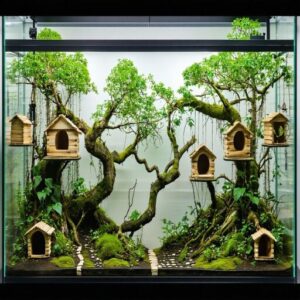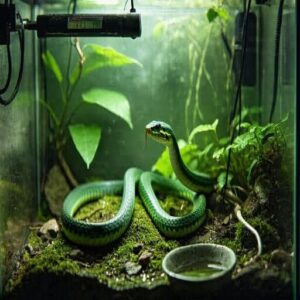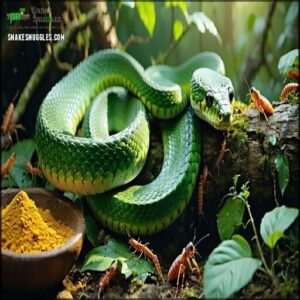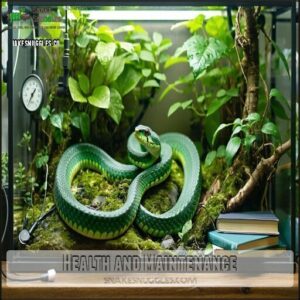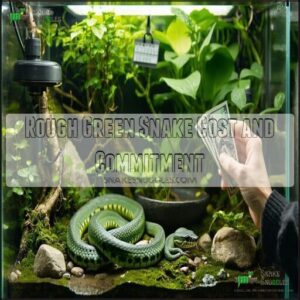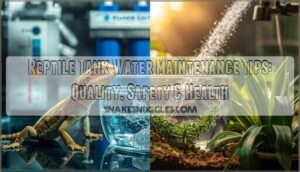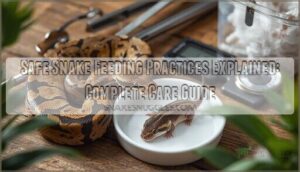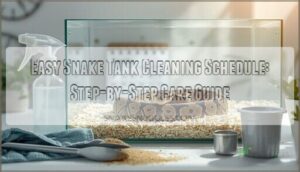This site is supported by our readers. We may earn a commission, at no cost to you, if you purchase through links.
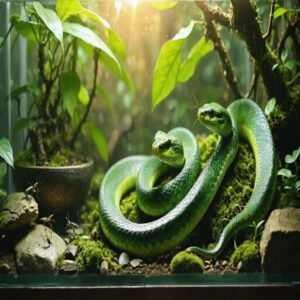
They’re insectivores, so you’ll mostly feed them crickets and other small insects—just remember to gut-load and dust their meals for proper nutrition.
These slender, arboreal snakes thrive in tall enclosures with plenty of branches for climbing and hiding.
Keep their habitat warm (75-85°F) with proper humidity and UVB lighting to mimic their natural environment.
While they’re generally gentle, they prefer minimal handling to avoid stress.
If you’re ready for a low-maintenance, visually stunning companion, a rough green snake might just be your perfect match!
Table Of Contents
- Rough Green Snake Overview
- Housing Your Rough Green Snake
- Temperature and Lighting
- Diet and Feeding
- Handling and Interaction
- Health and Maintenance
- Rough Green Snake Care Challenges
- Rough Green Snake Life Cycle
- Rough Green Snake Cost and Commitment
- Choosing a Rough Green Snake
- Frequently Asked Questions (FAQs)
- What Regulations Should I Check Before Acquiring a Green Snake?
- Are Rough Green Snakes Suitable for Beginners?
- What Dietary Supplements Should I Provide My Green Snake?
- How Often Should I Feed My Green Snake?
- What Are Some Signs of Health Issues in Green Snakes?
- Will a rough green snake bite you?
- How big of a tank does a rough green snake need?
- How long do rough green snakes live in captivity?
- Can rough green snakes be housed together?
- Can you keep rough green snakes as pets?
- Conclusion
Rough Green Snake Overview
You’ll discover that rough green snakes make fascinating pets with their vibrant emerald coloration and gentle, non-aggressive temperament.
Rough green snakes captivate with their striking emerald color and calm, curious nature, making them ideal companions for reptile enthusiasts.
These slender arboreal reptiles typically grow 2-3 feet long and can live 5-8 years in captivity when provided with proper vertical climbing space and a diet of soft-bodied insects.
They have a gentle nature, which makes them suitable for keeping as pets, and their care involves providing the right environment for them to thrive.
Natural Habitat and Appearance
Throughout the southeastern United States, rough green snakes thrive in lush, temperate habitats where their emerald scales create perfect camouflage. Their distinctive color patterns showcase vibrant green texture with keeled scales—a signature adaptation for their arboreal lifestyle.
Rough green snakes blend seamlessly into their lush, leafy surroundings, showcasing vibrant emerald scales perfectly designed for their arboreal lifestyle.
You’ll find these slender reptiles in dense vegetation near water bodies, where their snake camouflage allows them to virtually disappear among leaves. Their green snake habitat spans from southern New Jersey through riparian zones, demonstrating remarkable environmental adaptability.
When setting up your rough green snake care environment, mimicking these natural features is essential.
Size and Lifespan
While their emerald scales catch the eye, rough green snakes also impress with their dimensions.
These slender reptiles typically reach 24-36 inches in length, with females slightly outmeasuring males.
Under proper care, your snake can thrive for 5-8 years in captivity, with some reaching 15 years!
- Growth rates peak during the first two years
- Size variations exist between sexes (females have greater girth)
- Length increases from 10 inches at hatching to full size by 3 years
- Maturity occurs at approximately 18-24 months
Behavior and Temperament
Now that you know rough green snakes typically live 5-8 years and reach 2-3 feet in length, let’s examine their unique temperament.
Rough green snakes display distinctive behavior patterns that make them fascinating yet challenging pets. Their docile nature comes with specific temperament types that require understanding.
- They freeze completely when startled—a defense mechanism that showcases their non-aggressive disposition
- These arboreal specialists show clear stress signs when handled excessively, including rapid breathing and food refusal
- Their socialization methods differ from other reptiles, preferring observation over interaction
- Green snake behavior includes surprising bursts of curiosity followed by long periods of stillness
Handling tips include supporting their entire body while using slow, deliberate movements. Remember, these shy creatures prefer watching you from their branches rather than being held regularly.
Housing Your Rough Green Snake
You’ll need a 30-gallon hexagonal tank with secure mesh lid to properly house your rough green snake, ensuring ample vertical climbing space for this arboreal species.
Your enclosure should maintain a temperature gradient between 70-90°F and include abundant branches, live or silk plants covering at least half the tank, and multiple hiding spots at various heights to ensure the well-being of your rough green snake.
Enclosure Size and Material
When setting up a home for your rough green snake, choosing the right enclosure is essential for their health and happiness. A 20-gallon long tank provides the minimum space for a single adult snake, with secure mesh lids preventing escape attempts.
The tank dimensions should measure at least 18"L × 18"W × 36"H to provide adequate climbing structures. These arboreal reptiles need vertical space more than floor space.
| Material | Benefits | Considerations |
|---|---|---|
| Glass | Superior visibility, humidity retention | Heavier, higher cost |
| PVC/Plastic | Lightweight, affordable | Less durable |
| Custom Wood | Excellent insulation, natural aesthetic | Requires waterproofing |
Ensure proper ventilation needs are met through mesh tops or ventilation strips, while maintaining the 40-60% humidity these snakes require. Remember, even tiny gaps can lead to escape—rough green snakes are notorious for testing every corner of their enclosure!
For ideal snake care, consider reptile tank options that meet specific humidity and ventilation needs.
Substrate Options and Maintenance
With your snake’s home built, selecting the right substrate completes their comfort zone.
The substrate affects both cleanliness and humidity control in your rough green snake enclosure. Specialty rough green snake substrate is also available.
Choose from these snake-friendly substrate options:
- Coconut fiber (coir): Excellent humidity retention without promoting mold growth
- Cypress mulch: Natural, aromatic, and resistant to bacterial growth
- Sphagnum moss: Superior moisture control perfect for maintaining 60-70% humidity
- Paper towels: Ideal for quarantine or monitoring health issues.
Spot-clean daily by removing waste and soiled substrate.
Replace bedding completely every 4-6 weeks to prevent bacteria buildup.
Mist as needed to maintain proper moisture levels without creating soggy conditions.
Branches and Hide Spots for Climbing
Rough green snakes require extensive vertical space as arboreal species. Create a three-dimensional habitat with strategically placed climbing structures and hiding spots throughout their enclosure.
| Climbing Element | Benefit | Placement Tip |
|---|---|---|
| Oak/Maple Branches | Natural climbing texture | Secure firmly to prevent falls |
| Hide Boxes | Reduces stress | Position at various heights |
| Leafy Decor | Mimics natural habitat | Weave through branches |
For ideal terrarium design, arrange branches at different angles, creating multiple pathways. Your snake will exercise natural behaviors when provided with diverse climbing surfaces. Supplement with artificial plants to create concealing hiding places throughout the vertical space, promoting a natural habitat and reducing stress with hide boxes and leafy decor.
Temperature and Lighting
You’ll need to maintain a precise temperature gradient of 70-90°F in your rough green snake’s enclosure.
With a UVA/UVB light operating 10-12 hours daily for proper vitamin D3 synthesis, creating this controlled climate mimics their natural southeastern US habitat.
This controlled climate prevents health issues that can quickly derail even the most enthusiastic snake keeper’s experience.
Ideal Temperature Gradient
Thermoregulation is essential for your snake’s health. Create a temperature gradient with a basking spot of 85-90°F and a cool side around 70°F.
Ball pythons require a specific temperature gradient for ideal health and well-being. Nighttime temperatures can drop to 65-75°F for natural cycles.
- Use reliable heat sources like lamps.
- Monitor temperatures with digital thermometers.
- Adjust heat for balance.
- Guarantee consistent temperature control daily.
Lighting Options for Vitamin D3 Synthesis
Lighting plays a big role in your snake’s health.
UVB lighting boosts vitamin D3 production, aiding calcium absorption and bone strength.
Pair a heat lamp with UVB bulbs for balanced thermoregulation and photoperiod control (10-12 hours daily).
Position lights safely to prevent overheating.
Snakes like corn snakes thrive with UVB, showing 200% vitamin D3 increases!
Replace bulbs regularly for consistent intensity.
Here’s a quick guide:
| Lighting Type | Purpose | Replacement Frequency |
|---|---|---|
| UVB Bulb | Vitamin D3 | Every 6-12 months |
| LED Options | Visibility | As needed |
| Heat Lamp | Thermoregulation | Every 6 months |
| UVA/UVB Combo | Full-spectrum care | Every 6-12 months |
| Timer | Photoperiod Control | N/A |
Humidity and Ventilation Requirements
Proper climate regulation keeps your snake happy and healthy. Maintain humidity levels at 55-65% using misting and moisture control. A well-ventilated enclosure guarantees fresh air and prevents stagnant conditions.
- Mist the enclosure 1-2 times daily.
- Use substrate options like sphagnum moss for added moisture.
- Monitor air quality with a hygrometer.
- Verify your ventilation system promotes airflow.
- Increase humidity slightly during shedding periods.
Balanced humidity and ventilation create a safe, comfortable environment for your snake.
Diet and Feeding
Feeding your rough green snake isn’t complicated, but it does require attention to detail.
These insectivorous snakes thrive on a diet of soft-bodied insects, with occasional supplements for balanced nutrition.
Insectivorous Diet and Prey Items
A green snake’s diet revolves around an insectivorous feast that’s both nutritious and engaging.
Feeding techniques should encourage natural hunting instincts by offering live insects like moths, caterpillars, and spiders. Crickets and grasshoppers add variety, keeping the snake’s insect diet balanced and interesting.
Always focus on proper prey selection—choose insects smaller than the snake’s body width to prevent choking. Gutloaded insects, enriched with nutrient supplements, guarantee your snake gets essential vitamins and minerals.
Here’s a quick feeding guide:
| Insect | Frequency | Size | Preparation | Notes |
|---|---|---|---|---|
| Crickets | 2-3 times/week | Smaller than width | Gutloaded, dusted | Staple food option |
| Moths | Occasionally | Small | Live | Encourages hunting |
| Grasshoppers | Occasionally | Small | Live | High protein |
| Caterpillars | Weekly | Small | Live | Soft-bodied, easy to eat |
| Spiders | Weekly | Small | Live | Adds variety |
Keep their dietary needs in mind, and your rough green snake will thrive!
Feeding Frequency and Supplements
Stick to a feeding schedule of 2-3 times weekly to meet your snake’s dietary needs. Rotate insect variety for a balanced, insectivorous diet. Understanding snake care feeding is essential for their well-being.
Dust live or pre-killed insects with supplements for healthy growth.
- Use calcium powder to boost bone strength.
- Add vitamin-enriched dust for overall health.
- Offer gutloaded insects to maintain nutrient balance.
Gut-Loading and Dusting Insects
Enhance your snake’s health with gutloading and dusting methods! Before feeding, boost insect nutrition by offering prey nutrient-packed foods like carrots or leafy greens for 24 hours.
This feeding technique guarantees a richer, insectivorous diet for your rough green snake. Dust prey items with calcium powder to support bone growth, especially in young snakes.
Always use pre-killed insects to reduce stress during meals.
| Gutloading Foods | Dusting Frequency | Best Prey Types |
|---|---|---|
| Carrots | Every feeding | Crickets |
| Leafy Greens | Weekly | Grasshoppers |
| Sweet Potatoes | Bi-weekly | Waxworms |
| Squash | Every feeding | Moths |
| Bell Peppers | Weekly | Caterpillars |
Well-fed prey equals a thriving, happy snake!
Handling and Interaction
When handling a rough green snake, you’ll need a gentle touch and steady hands to keep it calm.
Limit interactions to reduce stress, and always wash your hands before and after.
Gentle Approach and Support
Handling a rough green snake requires patience and thoughtful care.
Follow these snake handling tips for a stress-free experience:
- Always use both hands for snake support, cradling its slender body gently.
- Practice calming techniques like slow, deliberate movements to keep it relaxed.
- Avoid gripping tightly; instead, use gentle care for soft restraint.
Limit handling to short sessions—these shy creatures thrive with minimal interaction, ensuring proper stress reduction as part of your rough green snake care routine.
Avoiding Excessive Handling and Stress
Respect your snake’s shy nature by keeping handling brief and purposeful.
Watch for signs of stress like hiding, refusing food, or unusual snake behavior patterns.
Stress reduction starts with minimal interaction and a calming environment.
Overhandling can lead to handling resistance or even illness. Stick to gentle approaches, and let your snake feel safe and secure in its space.
Washing Hands Before and After Handling
Before handling your rough green snake, wash your hands—it’s not just about hygiene; it’s about snake safety. Germs can harm your pet, and bacteria like salmonella can impact you.
After handling, wash again to stay safe.
- Hand hygiene: Protect your snake’s delicate immune system.
- Handling precautions: Avoid spreading germs between you and your pet.
- Cleanliness tips: Keep snake care basics stress-free and healthy for everyone.
Health and Maintenance
Keeping your rough green snake healthy requires regular vet checkups, proper humidity, and careful observation for stress or illness. By staying proactive, you’ll guarantee your snake thrives in captivity.
Regular Vet Checkups and Parasite Prevention
Regular vet visits are your snake’s secret weapon against health problems.
A reptile veterinary checkup every 6-12 months facilitates early detection of snake health issues like parasites or infections.
Parasite tests, including annual fecal exams, are vital for snake hygiene and disease prevention.
Think of it as a wellness tune-up for your pet!
Here’s a quick guide:
| Care Type | Frequency | Purpose |
|---|---|---|
| Routine Checkup | 6-12 months | General health checks |
| Fecal Examination | Annually | Parasite detection |
| Deworming Treatment | As needed | Parasite prevention |
| Weight Monitoring | Regularly | Guarantee healthy growth |
| Illness Observation | Ongoing | Spot signs of illness early |
Stick to these practices, and your snake will thrive!
Shedding and Humidity Assistance
Shedding, or ecdysis, is a natural part of a rough green snake’s life, but it’s not always smooth sailing. Proper moisture management is key to keeping their scale health in check and ensuring a complete, stress-free shed. Humidity control plays a starring role here—aim for 55-70% humidity in their enclosure.
When shedding begins, focus on these shedding tips to support your snake:
- Mist the enclosure daily to maintain consistent humidity levels.
- Provide a shallow water dish for soaking, boosting hydration and skin care.
- Include a humid hide box with damp sphagnum moss for a cozy, moisture-rich retreat.
- Gently assist stuck shed using a warm, damp cloth if necessary.
Think of humidity as your snake’s spa treatment—it keeps their skin supple and their shedding seamless!
Monitoring for Signs of Illness and Stress
Keeping an eye on your rough green snake’s health isn’t rocket science, but it does require attention to detail.
Stress signs, like lethargy, loss of appetite, or excessive hiding, can be early warnings of trouble. Behavioral changes, such as sudden aggression or frequent escape attempts, might signal discomfort or stress.
Watch for physical signs of illness, including wheezing, open-mouth breathing (a red flag for respiratory infections), or discolored scales, which could indicate fungal issues.
Regular health checks are your best defense—don’t wait for things to spiral. Use tools like a humidity gauge to prevent dehydration and shedding problems.
If your snake seems “off,” trust your gut and seek veterinary care promptly. Being proactive about illness detection guarantees your snake stays happy, healthy, and stress-free in its environment.
Rough Green Snake Care Challenges
Caring for rough green snakes isn’t always straightforward, especially with their specific needs and shy nature.
You’ll need patience and attention to detail to manage their health, stress, and handling challenges effectively, which can be a complex task requiring careful consideration of their unique requirements.
Common Health Issues
Respiratory infections often sneak up on rough green snakes, showing as wheezing or bubbling sounds.
Skin problems like fungal infections or scale rot stem from dirty enclosures or excessive moisture, while bacterial infections can quickly worsen without intervention.
Parasite control is essential—internal or external parasites may cause weight loss or irritated scales. Watch for signs of metabolic diseases or vitamin deficiencies linked to poor diets.
Keep your snake healthy with clean habitats, stable humidity, and a balanced diet. Prevention beats any snake health issues!
Behavioral Changes and Stress Signs
Spotting stress signals in your rough green snake starts with watching for subtle behavioral shifts. Stress can stem from snake anxiety or environmental issues, leading to noticeable changes in temperament.
Look out for these signs:
- Lethargy or unusual inactivity.
- Refusal to eat, even favorite insects.
- Excessive hiding, beyond normal behavior.
- Sudden aggression, like unexpected strikes.
- Discolored skin or shedding problems.
By addressing stress signs early and improving environmental enrichment, you’ll help your snake feel secure and maintain healthy behavior.
Overcoming Handling Resistance
Overcoming handling resistance in rough green snakes requires patience and the right approach.
These shy creatures often resist handling due to their timid snake temperament, but with consistent taming methods, you can build trust over time. Think of it as creating a support system for your pet—slow and steady wins the race.
Here are some effective snake handling techniques to help:
- Start slow: Keep handling sessions brief, just 2-3 minutes, to avoid overwhelming them.
- Use a gentle approach: Fully support their body with both hands, moving calmly and deliberately.
- Focus on stress reduction: Handle them in quiet, distraction-free environments.
- Watch for cues: If they freeze or recoil, pause and let them adjust.
With time, these steps encourage tame snake bonding and smoother interactions.
Rough Green Snake Life Cycle
Understanding the life cycle of a rough green snake helps you provide the right care at every stage. From egg-laying to adulthood, these snakes grow quickly with proper conditions.
Breeding and Egg-Laying
Spring marks the mating season for rough green snakes, with breeding typically starting once they’re around a year old.
Females, after successful mating behavior, lay 3-12 snake eggs, often becoming restless or digging beforehand.
To guarantee healthy egg incubation, create a moist, secure laying spot in the enclosure.
Without proper conditions, fertility issues can arise.
Keep in mind their sexing difficulty—males and females look alike!
With care, you’ll witness nature’s magic unfold through their reproductive cycle.
Incubation and Hatching
Egg incubation is where the magic starts! Once your snake lays 3-12 eggs, follow these steps:
- Place eggs in an incubator at 80°F using vermiculite substrate mixed with equal parts water.
- Maintain humidity consistently for 41 days—don’t peek too often!
- Watch for tiny shell slits signaling hatching day.
Carefully move the 8-inch hatchlings to their enclosure. Hatchling care begins with their first meal—tiny insects—within a few days.
Growth and Maturation
As your rough green snake grows, its journey to adulthood is fascinating.
Males mature by 21 months, while females take up to 33 months. Growth rate and size progression reveal key maturity indicators.
Look for:
- Increased activity during warmer months (April–November).
- Frequent shedding, signaling healthy growth toward their 2–3 foot snake size.
- Vivid green scales that brighten with age and smoother textures.
- Active feeding habits, reflecting their maturing instincts.
With proper care, they’ll thrive for 6–8 years, showcasing a remarkable snake lifespan and steady growth. Understanding their arboreal lifestyle habits is essential for providing the right environment.
Rough Green Snake Cost and Commitment
Owning a rough green snake requires more than just the initial purchase—it’s a long-term financial and time commitment.
From enclosure setup to ongoing care, you’ll need to budget carefully and stay consistent with maintenance.
Initial Purchase and Setup Costs
Starting your rough green snake care journey doesn’t break the bank, but setup fees add up quickly.
Here’s a breakdown of initial costs:
- Snake: Around $8-10, slightly higher from breeders.
- Tank Prices: A 20-30 gallon arboreal enclosure costs $100-200.
- Climbing Supplies: Branches, hides, and plants run $50-75.
- Heating Costs: UVB bulbs, heat lamps, and thermostats range $75-150.
Think of it as creating a cozy, tropical retreat for your pet snake! Properly selecting snake tank equipment is vital for their well-being.
Ongoing Care and Maintenance Costs
Caring for a rough green snake won’t break the bank, but you’ll need to plan for ongoing care.
Here’s a quick breakdown:
| Expense Category | Frequency | Estimated Cost |
|---|---|---|
| Food Expenses (insects) | Weekly | $5-10 |
| Substrate Replacement | Monthly | $10-15 |
| Heating Costs | Monthly | $5-10 |
| Vet Bills | Annual | $50-100 |
| Habitat Costs (upgrades) | As needed | $20-50 |
| Supply Budget | Quarterly | $15-25 |
Expect monthly snake maintenance to range from $30-50.
You can save on reptile pet care by bulk-buying insects or crafting DIY decorations.
Longevity costs like seasonal heating adjustments or vet emergencies can add up, so consider snake insurance to stay prepared!
Time and Attention Requirements
Balancing time and attention for your rough green snake is straightforward.
These low-maintenance pets fit well into busy lives, needing just 10 minutes daily for humidity misting and enclosure checks.
Weekly care schedules include feeding sessions (30 minutes) and occasional handling—limit this to 5-10 minutes to avoid stress.
Handling techniques and snake socialization require patience, but beginner-friendly pets like these thrive with steady owner commitment and consistent pet snake care routines, needing steady owner commitment and a focus on consistent pet snake care.
Choosing a Rough Green Snake
When choosing a rough green snake, focus on finding one that’s active, alert, and free of visible health issues.
Stick to reputable breeders or specialized pet stores to guarantee you’re bringing home a well-cared-for snake.
Selecting a Healthy Snake
Before bringing home your new rough green snake, it’s smart to master the art of Snake Inspection. Healthy snakes show bright, clear eyes, smooth, vibrant scales, and an active, curious demeanor. Avoid snakes that seem lethargic or show signs of illness.
Here’s a quick health checklist for your pet selection:
- Look for smooth scales without retained shed or injuries.
- Check the mouth for a clean, pink interior—no signs of rot.
- Watch for respiratory issues like wheezing or nasal bubbles.
- Confirm the body is free from lumps, swelling, or irregularities.
- Observe their behavior—healthy snakes explore confidently.
For peace of mind, consider a pre-purchase veterinary exam to confirm your snake’s health.
Researching Reputable Breeders
Finding reputable breeders for rough green snakes is paramount for responsible pet ownership. A good breeder guarantees healthy snakes and follows ethical practices. Thorough breeder research is essential.
Look for these signs: 1. Breeder Reviews: Positive feedback from past buyers.
- Snake Pedigree: Detailed lineage and health records.
- Breeding Ethics: Transparent facilities and adherence to reptile laws.
Avoid breeders who dodge questions or lack proper quarantine procedures. Schedule breeder interviews to discuss their methods and snake species list.
Trustworthy breeders prioritize rough green snake care over profits, ensuring your pet thrives.
Preparing for Your New Pet
Preparing for your rough green snake starts with the right green snake habitat setup. Choose a 20-30 gallon tank with a secure lid to prevent escapes.
Add branches, vines, and leafy décor for climbing and hiding—key snake enclosure ideas. Use safe substrates like coconut coir and include a heat lamp, water dish, and a humidity gauge.
Stock up on insects like crickets and mealworms.
Research breeders and locate a reptile-savvy vet.
Quarantine procedures guarantee safety, and a starter kit simplifies your rough green snake care journey!
Frequently Asked Questions (FAQs)
What Regulations Should I Check Before Acquiring a Green Snake?
Don’t assume it’s all smooth sailing—check local exotic pet laws, wildlife permits, and import restrictions.
Some areas ban non-native species, while others require documentation.
Always verify regulations to avoid fines or confiscation.
Are Rough Green Snakes Suitable for Beginners?
Rough green snakes aren’t ideal for beginners.
Their shy nature, stress from handling, and specific care requirements make them better suited for experienced reptile keepers who can provide a calm, controlled environment and proper care.
They require a keeper who can minimize stress and provide the right conditions, making them a choice for experienced reptile keepers.
What Dietary Supplements Should I Provide My Green Snake?
Did you know insects lose up to 50% of their nutrients post-capture?
Dust your green snake’s prey with calcium powder and multivitamins.
This guarantees strong bones, vibrant health, and avoids pesky deficiencies in your pet, ensuring they receive the necessary nutrients for optimal health.
How Often Should I Feed My Green Snake?
Feed your green snake two to three times a week with appropriately sized, gut-loaded insects.
Make certain each meal lasts about 20 minutes, and dust prey with calcium powder for balanced nutrition and healthy growth.
What Are Some Signs of Health Issues in Green Snakes?
When your snake hides excessively, refuses food, or breathes rapidly, it’s waving red flags.
Watch for lethargy, unusual shedding, or weight loss—these could signal stress, illness, or parasites.
A vet visit may be necessary.
Will a rough green snake bite you?
You’re unlikely to get bitten by a rough green snake.
They’re gentle, shy, and non-aggressive, preferring to flee rather than fight.
Even if provoked, their tiny teeth make bites harmless and barely noticeable.
How big of a tank does a rough green snake need?
Imagine this: your snake gliding gracefully through its home.
A 20-30 gallon tank with vertical climbing space is perfect.
Add branches, live plants, and secure lids to create a cozy, escape-proof haven.
How long do rough green snakes live in captivity?
Rough green snakes typically live 5-8 years in captivity with proper care.
Providing the right diet, humidity, and temperature can help them thrive.
With consistent attention, you might see them reach their full lifespan!
Can rough green snakes be housed together?
You can house rough green snakes together, but it’s risky.
They’re solitary by nature, and cohabitation may cause stress, competition for resources, or aggression.
If you try, provide ample space, hiding spots, and monitor closely.
Can you keep rough green snakes as pets?
You can keep rough green snakes as pets, but they’re best suited for experienced owners.
Their shy nature, specific care needs, and reluctance to be handled make them ideal for observation rather than interaction.
Conclusion
Imagine a pet that’s as striking as it’s low-maintenance—rough green snakes as pets fit the bill perfectly.
With their vibrant color, calm demeanor, and simple care needs, they’re ideal for reptile enthusiasts seeking a unique companion.
Provide them with a tall, well-equipped enclosure, proper lighting, and a steady diet of gut-loaded insects, and they’ll thrive.
While they’re not the most hands-on pets, their beauty and charm make them a rewarding addition to your home.



